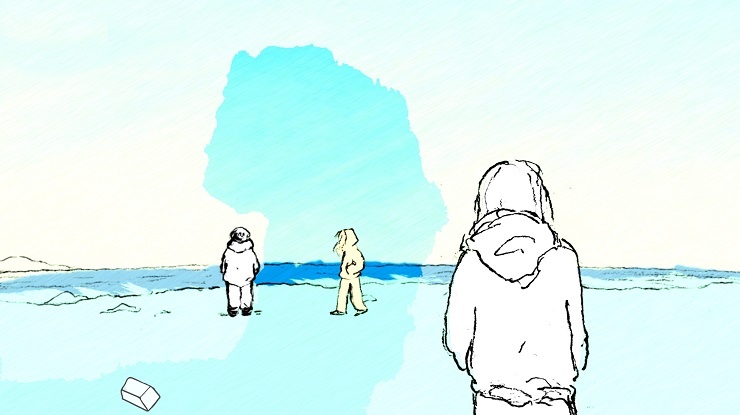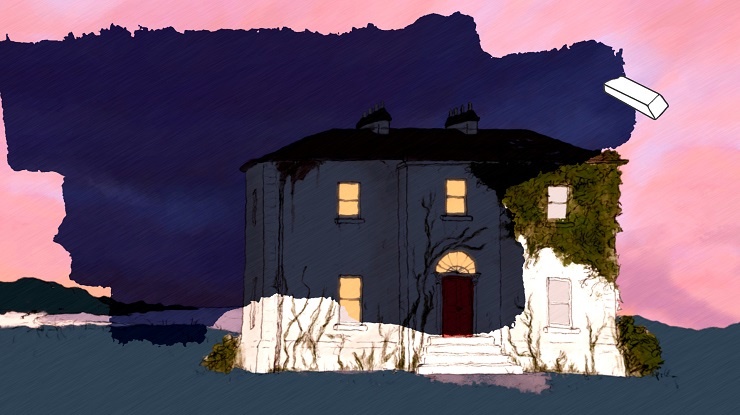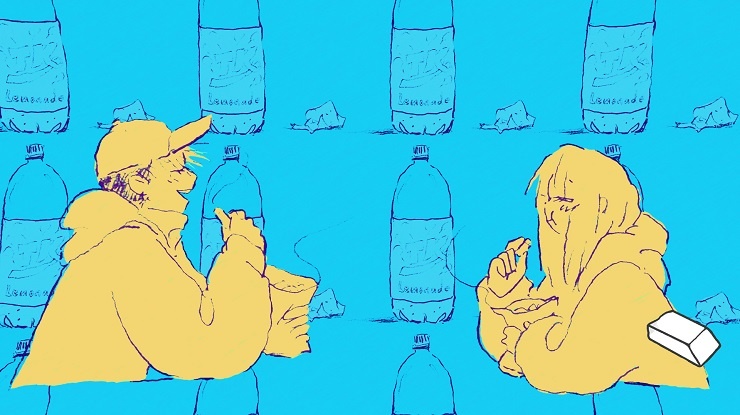Llaura McGee, Designer of If Found…, spoke with IG+ about the evolution of the game’s narrative, capturing dissociation, and its erasing mechanic.
If Found… is set in 1993 on the Irish island of Achill. What was your reason for picking this place and year specifically for the setting of the game?
Llaura McGee, DREAMFEEL: I grew up on the west coast of Ireland, not Achill specifically, but there’s a lot of overlap. It started from a general desire to represent what was unique to ourselves growing up there in the 90’s – the emotions good and bad – but as we dug into the story, it became more real.
We actually only decided last year to move from a fictional island to the real life Achill island. This was a point when the story was becoming much more serious, and setting it in a real life location comes with a responsibility to live up to it.
The early 90’s was there from the start. It signaled a lot of change in Irish society, and it was a time when a lot of things good and bad were coming out into the light. LGBT people were beyond invisible in rural Ireland, and homosexuality had just been decriminalized the year before.
Only when writing does the significance makes itself known, and you can’t really anticipate that completely when you start. You just set off in a direction hoping it will be a nice journey.
If Found… touches upon various topics such as the trans experience, found family, the experience of being part of a diaspora, and religion. What was your process in creating these narratives, and how did you manage to balance these individual threads?
A game is a souvenir of the time that was spent on it. There was an aim to represent a lot of things early on, and that’s all part of the Ireland we see.
But as the characters developed, it was just the natural result of trying to make them as honest as possible. Real characters reflect the world they live in, and worlds and themes feel most real and rich when they’re likewise reflected in the characters. Kasio wasn’t even trans to start with, but as we wrote it it quickly became head canon and then it quickly became fact.

There are two major story arcs in If Found…, one set in an unknown future, and the other set in 1993. What interested you in having two connected narratives rather than just the single story? How did they enhance one another?
Originally, they were one story with the emphasis on the sci-fi (and at the time, supernatural) elements! As we wrote Kasio, though, she really came into her own and her story and her family and her friends grew larger and larger and larger. So then the sci-fi story became something that only happened at the start and at the end, because it emotionally still felt so essential to the game. We had a version where it was almost entirely missing, too, but the game felt like there was a huge hole in its heart.
So, last year we were still a bit unsure about how they fit together – how Kasio related to Cassiopeia. Then, we had one of those “Oh, shit!” moments when we worked out how Mac fit, and it all clicked. Much like Cassiopeia and Mac, it was still a race to get everything done and in for the deadline. It’s stressful fun to see how bits come together in the end.
It’s like landing a plane. You can have great ideas and fly off into the sky, but it only really works if you can land (and you’re usually on a super tight deadline and juggling a hundred other parts of the story/game going through the same process). I think our landing was a little bumpy with this part of the story, but since the patch last weekend, I’ve made a few tweaks and I’m really proud of it.
I hope the space sections and those two characters are something that grow on people. I think it’s one of the saddest, hopeful, and strange parts of the game. I’ve wondered if I should have made Cassiopeia sadder to complement Mac, but I think I ultimately want to make a hopeful game. I think people could definitely have a sad reading on her though. Maybe I’ll tweak a line for a future patch [laughs].
Besides the narrative and emotional purpose, I think it’s cool to have simultaneously moving stories and it’s something I think more games should.
What was the main decision behind making segments of If Found… an interactive journal versus a more traditional visual novel format?
We were never consciously making a visual novel; that’s a descriptor that was applied after we finished. We started with the interactive journal, then we added the dream sequences, and, late in the game, we added the dialogue sections. They were added to break up the erasing and to let us get more character moments in easily.
We also had free movement until late 2018, but it was just too complex and got in the way. So, we simplified our way towards something like a visual novel. For us, genre is not important. What’s important is how to best communicate the storytelling and the feelings we’re aiming for.
I’m happy for it to be called a visual novel. I’ve also heard it described as a “point & erase” game, which I really like.

If Found… uses an eraser as a primary mechanic, letting players “erase” events to move forward in the story. Why did you make this a persistent mechanic through a good chunk of the game, and what is it you were aiming to communicate to the player with this feature?
From a gameplay perspective, it’s compelling. It lets players play in different ways. You can make the eraser huge and blast through the game, or you can make it very small and change things delicately. But we made this game because of the conflicting and interesting emotions the erasing expressed.
Originally (ie, for a couple weeks in 2015) we were making a different game where the mechanic would change every chapter. I realized that making an interactive metaphor that changed every ten minutes could actually be really tacky and obvious.
Sometimes, when people try to make expressive game mechanics, they think the best way is coding a message directly into the mechanic, like walking to the right is like getting older or whatever. I feel like that approach is, by definition, really reductive.
I think good writing is open to interpretation – rather than just saying a character is sad, having a moment that illuminates it. Because the erasing goes across most of the game, its meaning and importance can shift and change in context. Lots of people see it very differently and that’s really exciting and rewarding.
Regarding the visual direction of If Found… there was a segment near the tail end of the game that had such evocative imagery, as someone who suffers from mental illness that felt so wholly representative of dissociation. What were your inspirations for this segment, and what was the emotion (or experience) you were aiming for?
That’s really cool you felt that. I definitely wanted to express Kasio’s dissociation from reality.
It’s not from her being trans, although many trans people experience numbness and dissociative feelings before transition, but often with transition, this gets better. Kasio throughout is pretty chill about her identity, but transitioning doesn’t mean we’re perfectly well all the time.
The stress and the struggle of coming out and everything that happens just completely overwhelms her and her ability to process anything that’s going on. She falls into a spiral where all her thoughts and feelings are running away without her. She can’t control them.
There was always a beat like this in the story where Kasio erased everything/the galaxy, but originally it was at the start of the game and it was more anger directed outward, rather than the inward dissociation it is in the final game.
It was definitely partly inspired by a couple episodes in my life. When working on the game actually, when struggling with my own mental illness, I lost the thread of where I was and what was happening. Time ceased to exist and it was pretty scary. Brid repeating “everything is okay,” trying to bring Kasio back to reality is a pretty direct parallel with my partner saying the same.
If Found… is available now on the App Store, itch.io, and Steam.


I can’t believe the story was made from scratch. I was convinced it was largely based on someone’s actual diary. Great writing!